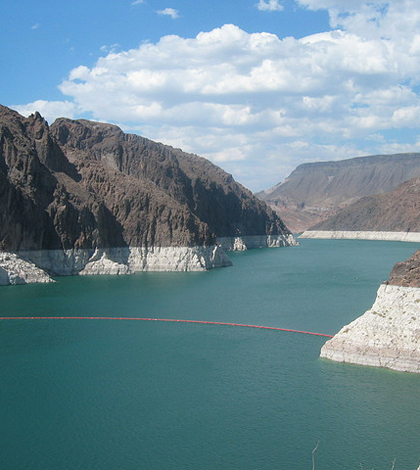Improved Water Treatment cleans up Lake Mead water (VIDEO)

A new U.S. Geological Survey documentary shows that Lake Mead’s water quality improved due to revamped water treatment efforts and phosphorus mitigation.
The famed Lake Mead, abutting the Hoover Dam, is Las Vegas’ lifeline.
Initiatives to improve water treatment started after a 2001 algal bloom turned the massive lake green.
Las Vegas officials and federal organizations responded aggressively. The Southern Nevada Water Authority built a second water treatment facility. J.C. Davis, a spokesman for the water authority, said the plant was built both to improve water treatment and deal with increased peak day demands of desert summers.
Workers placed the intake for the second treatment plant 50 feet below the intake for the first treatment plant. Davis said this allows the water authority to draw the cleanest drinking water possible based on lake temperature stratification.
The lake’s surface is generally more contaminated. Davis said the lower intake is used to draw clean water until surface contaminates sink. The water authority then switches to the upper intake to keep drawing the cleanest water possible.
The water authority also spearheaded restoration of the Las Vegas Wash, an area of land that carries natural streams, waste water effluent and runoff from the city into Lake Mead.
In the 1960s, runoff from the city developed into a wetland in the wash. As Las Vegas, grew so did runoff. This eventually overwhelmed the wetlands and created a channel into the lake. “Ironically the wetland died from too much water,” Davis said.
Southern Nevada Water Authority workers installed a series of weirs, or small dams, to create cascading pools. This slows water and allows it to pool, refurbishing wetland areas.
Combined efforts have led to improved water quality in Lake Mead. Davis said drinking water quality has never been a problem, but, “The better surface waters you can start with, the better off the community is.”
Lake Mead is monitored heavily by a variety of federal organizations including the U.S. Geological Survey and the Environmental Protection Agency.
Check out the USGS documentary below to see more on historical water quality improvements of Lake Mead and one of the USGS floating monitoring stations.
Top image: Lake Mead (Credit: kyle simourd, via Flickr)
[youtube id=”ka-qqJAnDd4″ width=”600″ height=”360″]




0 comments